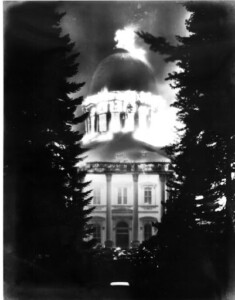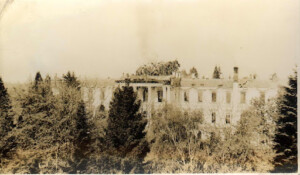Capitol Devoured by Fire for a Second Time April 25, 1935

1935-04-25, Oregon State Capitol Bldg. the night of 4/25/1935. View is to the East. Looking at the West entry. Large photograph depicting the state capitol up in flames. Large trees surround either side of the building. WHC Collections 2001.003.0002
In a spectacular blaze which began as Salemites ate dinner, the Oregon State Capitol was destroyed by fire a second time on April 25, 1935. Smoke was discovered coming out of an elevator shaft at about 6:30 that evening; the fire had apparently started in the basement of the 59-year-old statehouse.
Firefighters up and down the valley rushed in to try to save the brick and sandstone structure, but the fire had already reached the dome when they arrived, and smoke poured out of it. The flames moved quickly, spreading between walls, and racing from the basement up through an elevator shaft to the east wing roof and finally to the dome. The copper dome collapsed, its exterior timbers giving way, its copper sheeting crumpling. Three pumpers arrived from Portland, and Salem put nearly all its available equipment at the scene. Firefighters cut holes in floors in order to pour in water and chemicals, but to no avail.
A north wind began to blow sparks toward Willamette University, where college boys armed with hoses protected campus buildings. A Willamette University sophomore, Floyd McMullen, was killed while fighting the fire, felled shortly before midnight when a cornice from the northwest corner of the building fell on him, fracturing his skull and crushing his pelvis. McMullen, who had worked his way through college as a “call” fireman out of the East Salem Station, was rushed to the hospital where he was later pronounced dead.
News of the fire spread quickly through Salem, and the statehouse grounds were soon jammed with spectators, State officials among them. With the dome in flames, the fire was visible as far away as Silverton and Woodburn, and people drove in from surrounding towns to get a look. The Capital Journal estimated that a crowd equal the population of Salem, or 27,000, crowded into the city to watch what columnist Don Upjohn called “Salem’s worst holocaust.”
Within hours, the once lovely Capitol had been devoured by the flames, leaving only brick walls standing amid piles of charred rubble. Built at a cost of $320,000 and valued at $2,000,000, the structure was a total loss, with the State carrying no insurance on it. All State offices on the second and third floors, plus most of the first floor, had been destroyed. Some records and treasures had been saved in frantic efforts as the building burned, but many were lost, including oil paintings of all the governors, and of Jason Lee and Dr. John McLoughlin. Furnishings and files in the Governor’s Office were lost, though his personal effects were saved.
The fire prompted many to remember ruefully that an earlier Secretary of State had fought hard for construction of a $25,000 vault in which all State records could be safely held–only to have his plan vetoed by Governor Julius Meier. Still, losses of files and records were not as bad as was originally anticipated.

1935-04, April 1935, View of Oregon State Capital Building after the fire, looking southwest to the northeast. Capitol dome collapsed on top of building. WHC Collections 0082.024.0002.006
So much water was pumped out of the City system that citizens worried about the quality of their drinking water–although no problem was subsequently detected. The Capitol building became something of a tourist attraction, with people coming immediately from Portland and Eugene to view its skeletal remains. Indeed, the Capital Journal reported that a party from Seattle had flown into Salem the night of the disaster just to see the conflagration.
State clerks spent the day after the fire sorting through saved records and filing cabinets, removed to the armory during the fire. The businessmen of Salem called a special session of the Salem Chamber of Commerce to offer space for State offices displaced by the fire, which were quickly set up at various locations, including the Oregon Building and the Supreme Court Building. President Franklin D. Roosevelt sent a cable expressing his sympathies and offering federal aid in rebuilding.
Compiled and written by Kathleen Carlson Clements
Bibliography:
Capital Journal, April 26-May 2, 1935
Oregon Statesman, April 26, 1935
This article originally appeared on the original Salem Online History site and has not been updated since 2006.







Leave A Comment